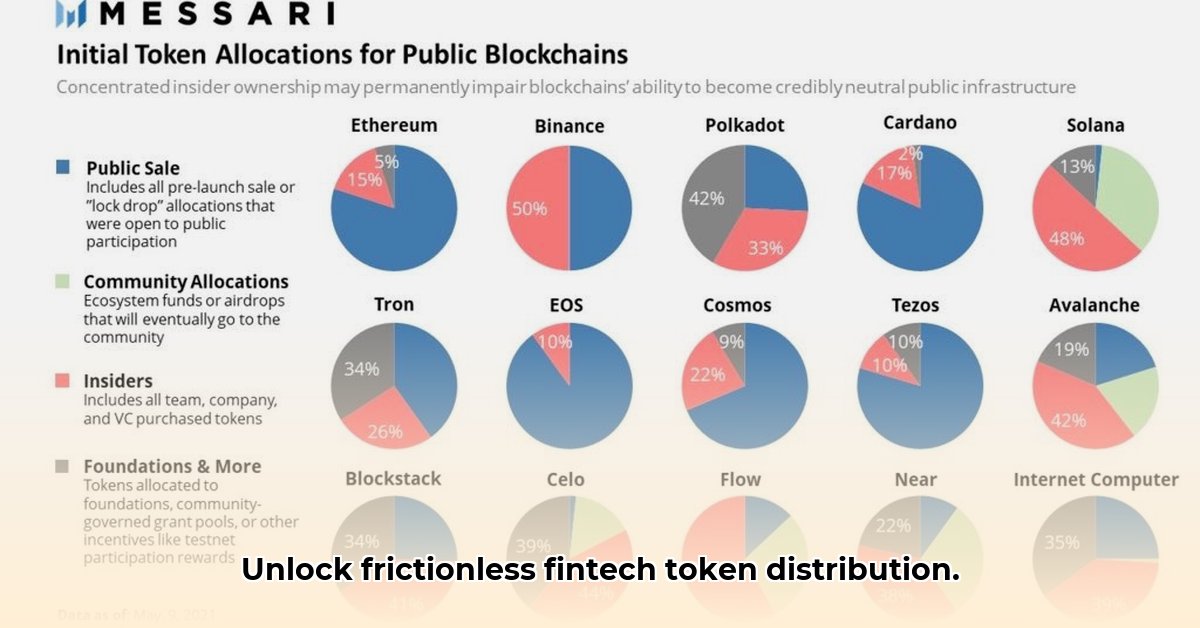
Fintech's explosive growth, fueled by blockchain and digital assets, presents both unprecedented opportunities and significant challenges. One key hurdle? Effectively managing token distribution. This article provides a comprehensive overview of token distribution in the fintech landscape, offering actionable advice for issuers, investors, regulators, and technology providers. We will explore the crucial role of token tables, explain how technology streamlines the process, and detail best practices for navigating the complex regulatory environment. Are you ready to optimize your token distribution strategy?
What is a Token Table (and Why It Matters)?
A token table (also known as a token cap table) is a detailed record of your cryptocurrency project's token distribution. It meticulously lists each token holder, specifying their holdings and acquisition dates, much like a company's shareholder registry. Its importance cannot be overstated. A well-structured token table fosters transparency, simplifies fundraising, and is crucial for regulatory compliance. It’s the bedrock of trust and accountability in the digital asset world. Without one, you risk a chaotic and potentially legally problematic situation.
The Token Distribution Landscape: Navigating Growth and Uncertainty
The fintech market is experiencing remarkable expansion. Platforms specializing in token distribution manage billions of dollars annually. However, this rapid growth introduces challenges, primarily regulatory uncertainty. International variations in cryptocurrency regulations create significant hurdles for projects operating globally. Further complicating matters is the integration of on-chain identity verification, enhancing the precision of airdrops (direct token distribution) while also raising privacy concerns. The need to balance efficiency, security, and privacy is a critical ongoing challenge.
Streamlining Token Distribution with Technology
Technology is rapidly transforming token distribution. Smart contracts automate various processes, simplifying large-scale airdrops and vesting schedules (planned token releases) by minimizing manual intervention and errors. On-chain identity verification adds precision and security, but necessitates careful consideration of data privacy. The use of visual aids, such as flowcharts, clarifies complex distribution processes, making them easier for both technical and non-technical stakeholders to understand.
Regulatory Compliance and Risk Management: A Proactive Approach
The regulatory landscape for token distribution remains dynamic and complex. Countries employ varying interpretations of KYC/AML (Know Your Customer/Anti-Money Laundering) regulations, data privacy laws, and rules governing the classification of cryptocurrencies as securities. Proactive legal counsel is essential.
Here's a simplified risk assessment matrix illustrating potential challenges and mitigation strategies:
| Risk Category | Likelihood | Impact | Mitigation |
|---|---|---|---|
| Security/Fraud | Medium | High | Robust security measures; diverse distribution routes; regular independent audits |
| Privacy Violation | Low | Medium | Privacy-preserving techniques; strict adherence to data protection laws |
| Smart Contract Bugs | Medium | High | Comprehensive code audits; rigorous testing; experienced developers |
| Regulatory Non-Compliance | High | Very High | Expert legal counsel; continuous monitoring; adaptable distribution procedures |
Actionable Steps for Stakeholders: A Practical Guide
Implementing effective token distribution requires a coordinated effort from all stakeholders. Below are actionable steps tailored to each group:
1. For Token Issuers:
- Create a transparent and accessible token table.
- Leverage established token distribution platforms.
- Conduct thorough due diligence on all regulatory aspects.
- Utilize on-chain identity verification strategically, addressing privacy concerns.
2. For Investors:
- Prioritize projects with well-defined token tables and tokenomics.
- Always undertake thorough due diligence before investing.
- Review all relevant regulatory compliance documentation.
- Diversify investments to mitigate risk.
3. For Regulatory Bodies:
- Develop clear and consistent guidelines for token distribution.
- Foster international collaboration to harmonize regulations.
- Establish standards for token table disclosure.
- Stay updated on technological advancements.
4. For Technology Providers:
- Enhance platform security and user-friendliness.
- Develop and implement privacy-preserving identity verification.
- Prioritize interoperability between systems.
- Invest in decentralized identity solutions (DIDs).
Conclusion: Building a Trustworthy Token Ecosystem
The future of token distribution rests on transparency, robust security, and regulatory compliance. A well-maintained token table is not merely a document; it is a fundamental element of a successful and trustworthy project. By embracing the best practices outlined in this article, we can collectively foster a secure and reliable token ecosystem for a more efficient and transparent fintech future. The landscape is dynamic, necessitating continuous learning and adaptation. Have you considered the implications of a poorly managed token distribution on your project's success?